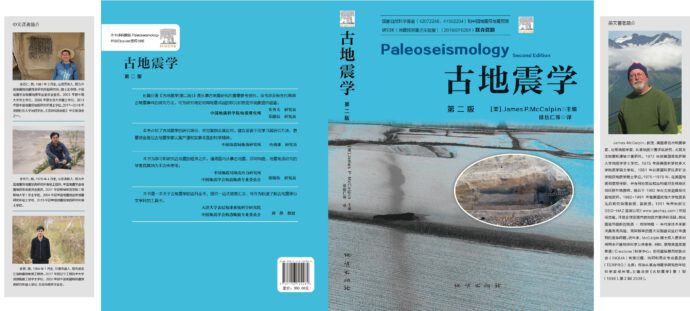The recognition of sedimentological traces of earthquakes in the form of seismites within Pleistocene sediments is the main objective of the GREBAL project (Recognition of traces left by earthquakes in Pleistocene sediments affected by glacio- isostatic rebound in the Baltic Sea Basin). The investigations focus primarily on Poland, Germany, Latvia, Estonia and Lithuania. Project leader Małgorzata (Gosia) Pisarska-Jamroży has summed up new results from this international research effort.
more-
New results from the GREBAL Project – Traces of Pleistocene earthquakes in the Baltic Basin
2021-02-08 | in Earthquake, Field work | one response -
Christoph GrütznerCC BY-SA 3.0
New papers on paleoseismology, earthquakes, and active tectonics (Feb 2021)
2021-02-02 | in PaperThis time we have a lot of papers on the active tectonics of the Americas, especially along their west coast. Of course on the west coast you say? Sure, but the recent M5.6 in Guyana, a shallow thrust event in a seemingly aseismic area, reminded us that such quakes can basically happen everywhere and at any time – they are just rare and hard to find in the geological record. Enjoy reading!
more -
Philipp Balling
28–17 Ma old uplifted marine terraces in the Dinarides
2021-01-29 | in PaperIn 2018, back then when we didn’t even knew about Covid-19, I was sitting in a little restaurant in Slovenia with my happy field team. We were exhausted from another long day of geophysical surveys for our active tectonics project and quite thirsty. A colleague of mine, Philipp Balling, had just finished his field work in Croatia and was on his way north to join us for a few days before he would continue to Jena. He arrived late that evening and we had a great time catching up with each others stories from the field. He showed me a few photos, one of them displaying a huge, flat area at the Croatian coast. I was immediately alerted and asked if the Croatian coast was uplifting, because this thing looked like a marine abrasion platform to me. We chatted about uplifted marine terraces until long after midnight, and this is how the story of this paper began.
more -
Postdoc position in Upper Plate Deformation at UNAM, Mexico City
2021-01-14 | in JobsThe following open position might be of interest to the Active tectonics and
Paleoseismology community:
moreUNAM is seeking a Postdoctoral Research Assistant for a 12 month fixed term appointment working on the exciting UNAM-CONACYT-funded project on “Spatial and Temporal Variations of Upper Plate Deformation across the Guerrero portion of the Mexican Subduction Zone” at the Institute of Geography and the Tsunami and Paleoseismology Laboratory, National Autonomous University of Mexico (UNAM), Mexico City Campus. The candidate will pursue fundamental and applied research into the assessment of both temporal and spatial vertical crustal deformation associated with both slow (interseismic) and rapid (coseismic) crustal deformation across the inner forearc region of the central Mexican subduction zone on the Guerrero sector, where the Cocos plate underthrusts the North American plate. The candidate will be responsible for the development and execution of laboratory and field research, conduct studies to develop a model of long-term deformation, coseismic deformation and earthquake/tsunami chronology, writing reports and papers.
-
古地震学: “Paleoseismology” by Jim McCalpin now available in Chinese
2021-01-12 | in paleoseismicity.org, PaperJim McCalpin’s famous “Paleoseismology” is now also available in Chinese. The book was translated by Xu Yueren, Li Wenqiao, and Du Peng.
- Price: 300 Yuan
- ISBN: 978-7-116-12228-4
- Printed in Beijing, October 2020
- Details and where to buy it: https://www.mine999.cn/news/show-415182811.html

By the way, “Палеосейсмология” is also available in Russian: https://www.livelib.ru/book/1001089368-paleosejsmologiya-komplekt-iz-2-knig-cd
-
Christoph GrütznerCC BY-SA 3.0
Earthquake geology & active tectonics sessions at vEGU21
2021-01-05 | in MeetingThis year’s EGU will be held from 19-30 April. It will be another virtual conference, which is why it’s named vEGU21. Anyway, there are many interesting sessions, and a couple of them could be very interesting for paleoseismologists, earthquake geologists, and active tectonics aficionados. For example, EDITH is also a project of INQUA‘s TERPRO commission.
more -
Christoph GrütznerCC BY-SA 3.0
New papers on paleoseismology, earthquakes, and active tectonics (Jan 2021)
2021-01-01 | in PaperSome colleagues told me that 2020 was the most productive year they ever had – without the distraction of field work and meetings they managed to write up a lot of things they’ve had on their desks. Others reported exactly the opposite. In any case, I hope that this year life will go back to normal and I wish you a wonderful 2021.
more
Here are the latest papers, quite a good start into the next decade. Stay safe! -
This was the virtual PATA short meeting 2020
On 18 December we held a short virtual PATA meeting, since the in-person meeting to be held in Chile had to be postponed to 2021. The PATA Days (Paleoseismology, Active Tectonics, Archaeoseismology) are the main event of INQUA TERPRO‘s earthquake science community, led by the project TPPT (Terrestrial Processes Perturbed by Tectonics). Most of us are starving for joint field trips and personal contacts, but it was nice to at least see everyone online – more than 170 people attended the 1.5 hrs event. The five main topics were:
more -
Several PhD, postdoc, and professorship opportunities in active tectonics (and related fields)
-
How to access the PATADays virtual meeting, Dec. 18, 2020
2020-12-17 | in PATA daysWhile the real PATA Days in Chile have been postponed to 2021, we will run a short virtual meeting on Dec 18, 2020 in order to keep the spirit alive. Here’s how to take part:
more
